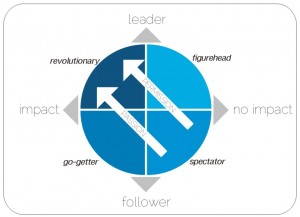I recently posted a comment to an online discussion. The question was, When did you first realize you were a leader?
In my response, I stated that my first leadership role was eraser monitor. “The job of the eraser monitor was to take the erasers from the chalkboard (do we still use chalkboards?) outside and bang them together to get the chalk off them. The monitor always returned to the room a bit pale.”
As a child, and well into adolescence, I viewed leadership as a role or position that someone filled. You were a leader if you had the title, the t-shirt, and the nametag. If you didn’t have a position, you weren’t the leader.
This brings us back to the Impact Graph. There are two measurements in the graph. One distinguishes between leaders and followers, the other between impact and no impact. In the last post, I describe those who fall into the follower-no impact category as “spectators.” In this post, I want to address the leader-no impact category. A group of people I like to call “figureheads.”
I see the figurehead group quite a bit on our campus. Every year we will go through an election and selection process to fill the “leadership” positions for the following year. These include such positions as student government, resident assistants, class council, club leadership, peer mentors, etc. All of these positions have responsibilities and tasks that must be accomplished, as well as people to be guided throughout the year.
Unfortunately, some students — once selected or elected — don’t do anything. They are…figureheads.
A figurehead has the following characteristics:
- Holds a “position” of leadership (which is the lowest form of leadership) but doesn’t do anything to lead within the position.
- Does the least required. Perhaps focusing on the perceived benefits of holding a position (power, prestige, resume’ builder).
- Fills a position for the wrong reasons (typically selfish).
- Works alone in accomplishing the tasks of the position with no effort to engage or involve people.
It is very tempting to think that you only need a position and then you’ll be recognized as a leader. While many people are elected or selected to a leadership position because they’ve demonstrated skill and abilities in a certain area, a student doesn’t become a student leader by position alone. You have to actually lead (move to the left of the graph).
If you are currently in a student leadership position, there are some questions you can ask yourself to make sure you don’t fall into “figurehead” status:
- Are you getting other people involved through your position?
- Why did you run or apply for this position?
- What have you accomplished through your position and who’s helped you accomplish it?
Don’t settle for being a figurehead. In the next series post, I’ll move to the impact side of the graph and talk about what it takes to be a “go-getter”.
Share this Post

